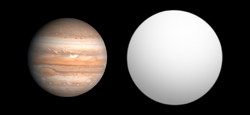Astronomy:HR 8799 d
 Size comparison of HR 8799 d (gray) with Jupiter. | |
| Discovery | |
|---|---|
| Discovered by | Marois et al. |
| Discovery site | Keck and Gemini observatories in Hawaii |
| Discovery date | November 13, 2008 |
| Direct imaging | |
| Orbital characteristics | |
| ~24 AU | |
| Eccentricity | >0.04[1][note 1] |
| Orbital period | ~100[2][note 2] y |
| Star | HR 8799 |
| Physical characteristics | |
| Mean radius | 1.2+0.1−0[2] |♃|J}}}}}} |
| Mean density | 4+1.75−1.1 kg m−3 |
| Rotation period | 6.0+11.3 −2.5 h[3] |
| Equatorial rotation velocity | ~10.1+2.8 −2.7 km/s[3] |
| Physics | 1090+10−90[2] |
HR 8799 d is an extrasolar planet located approximately 129 light-years away in the constellation of Pegasus, orbiting the 6th magnitude Lambda Boötis star HR 8799. It has a mass between 5 and 10 Jupiter masses and a radius from 20 to 30% larger than Jupiter's. The planet orbits at 24 AU from HR 8799 with an eccentricity greater than 0.04 and a period of 100 years. Upon initial discovery, it was the innermost known planet in the HR 8799 system, but e, discovered later, is now known to be closer to their parent star. Along with two other planets orbiting HR 8799, this planet was discovered on November 13, 2008 by Marois et al., using the Keck and Gemini observatories in Hawaii. These planets were discovered using the direct imaging technique.[2][4][5][6]
Near infrared spectroscopy from 995 to 1769 nanometers made with the Palomar Observatory show evidence of acetylene, methane, and carbon dioxide, but ammonia is not definitively detected.[7] In 2021, the further detection of water and carbon monoxide in the planetary atmosphere was made with the Keck Planet Imager and Characterizer (KPIC).[3]
See also
Notes
References
- ↑ Fabrycky et al. (2010). "Stability of the directly imaged multiplanet system HR 8799: resonance and masses". Astrophys. J. 710 (2): 1408–1421. doi:10.1088/0004-637X/710/2/1408. Bibcode: 2010ApJ...710.1408F.
- ↑ 2.0 2.1 2.2 2.3 Marois, Christian; Barman, Travis; Zuckerman, B.; Song, Inseok; Patience, Jennifer; Lafrenière, David; Doyon, René (November 2008). "Direct Imaging of Multiple Planets Orbiting the Star HR 8799". Science 322 (5906): 1348–1352. doi:10.1126/science.1166585. PMID 19008415. Bibcode: 2008Sci...322.1348M.
- ↑ 3.0 3.1 3.2 Wang, Jason J.; Ruffio, Jean-Baptiste et al. (2021-07-14). "Detection and Bulk Properties of the HR 8799 Planets with High-resolution Spectroscopy". The Astronomical Journal 162 (4): 148. doi:10.3847/1538-3881/ac1349. Bibcode: 2021AJ....162..148W.
- ↑ "Astronomers capture first images of newly-discovered solar system" (Press release). W. M. Keck Observatory. 2008-11-13. Archived from the original on 2013-11-26. Retrieved 2008-12-02.
- ↑ "Gemini Releases Historic Discovery Image of Planetary First Family" (Press release). Gemini Observatory. 2008-11-13. Retrieved 2008-12-02.
- ↑ Achenbach, Joel (2008-11-13). "Scientists Publish First Direct Images of Extrasolar Planets". The Washington Post. https://www.washingtonpost.com/wp-dyn/content/article/2008/11/13/AR2008111302267.html. Retrieved 2008-12-02.
- ↑ B. R. Oppenheimer (2013). "Reconnaissance of the HR 8799 Exosolar System I: Near IR Spectroscopy". The Astrophysical Journal 768 (1): 24. doi:10.1088/0004-637X/768/1/24. Bibcode: 2013ApJ...768...24O.
External links
- "HR 8799 d". Exoplanets. http://media4.obspm.fr/exoplanets/base/planete.php?etoile=HR+8799&planete=d.
Coordinates: ![]() 23h 07m 28.7150s, +21° 08′ 03.302″
23h 07m 28.7150s, +21° 08′ 03.302″
 |

